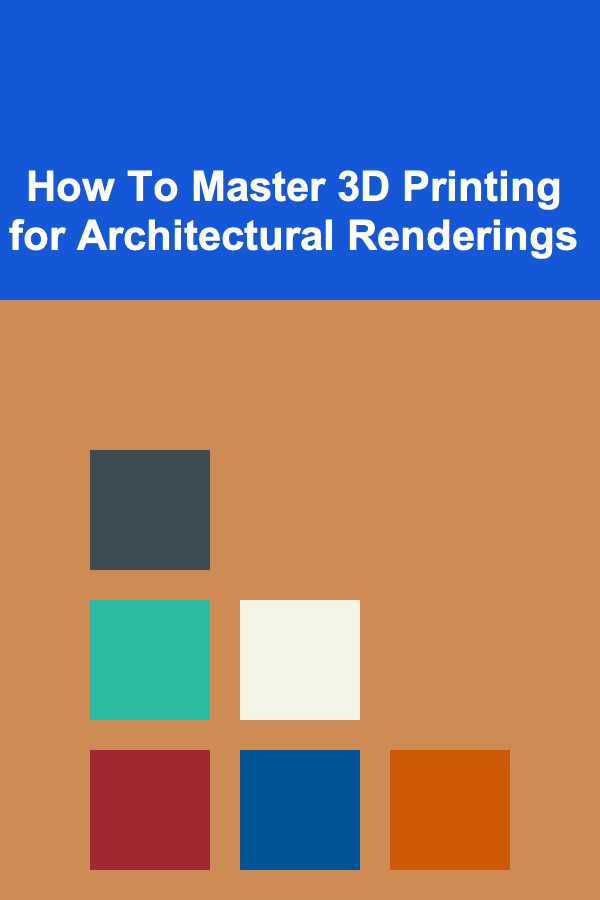
How To Master 3D Printing for Architectural Renderings
ebook include PDF & Audio bundle (Micro Guide)
$12.99$6.99
Limited Time Offer! Order within the next:

3D printing, also known as additive manufacturing, has revolutionized numerous industries, and architecture is no exception. Architects, designers, and construction professionals are increasingly turning to 3D printing to enhance the accuracy, efficiency, and creativity of their work. With its ability to produce intricate and highly detailed models quickly, 3D printing has become a game-changer in the field of architectural renderings. In this article, we will explore how to master 3D printing for architectural renderings, from understanding the technology to choosing the right tools, techniques, and processes that bring architectural designs to life.
The Evolution of 3D Printing in Architecture
1.1 The Early Beginnings
While 3D printing technology has been around since the 1980s, its application in architecture is relatively new. Initially, architects used 3D printers mainly for prototyping. Early models were simple and produced rough, often oversized, representations of buildings or structures. However, as 3D printing technology advanced, the potential for creating highly detailed, scalable, and functional architectural models became evident.
1.2 The Current State of 3D Printing
Today, 3D printing in architecture has evolved into a highly sophisticated tool for both conceptual design and construction. Architects can create detailed, accurate models of buildings and entire urban layouts. With advancements in materials such as concrete, metal, and composite resins, the types of structures that can be printed are now vast and varied. From intricate facades to complex interior layouts, 3D printing is enabling architects to visualize and communicate their designs more effectively than ever before.
1.3 The Future of 3D Printing in Architecture
As technology continues to improve, 3D printing is poised to play an even more significant role in architecture. The potential for fully functional, printed buildings---whether for use in temporary installations, as art, or even as permanent housing---is rapidly expanding. Innovations in material science, such as printable solar cells and self-healing concrete, promise a future where 3D printing could contribute to more sustainable and energy-efficient designs.
Understanding the Basics of 3D Printing Technology
2.1 What is 3D Printing?
3D printing is a process where three-dimensional objects are created from a digital model through the sequential layering of materials. This method contrasts with traditional subtractive manufacturing techniques, where material is removed from a solid block to create the desired shape. In architecture, 3D printing allows designers to create complex geometries and detailed structures that would be challenging, time-consuming, or costly to achieve using conventional methods.
2.2 Key Types of 3D Printing Technologies
Several 3D printing technologies are widely used in architecture:
- Fused Deposition Modeling (FDM): FDM is one of the most common 3D printing technologies, ideal for rapid prototyping and model making. It works by melting a filament of thermoplastic material and extruding it in layers to form the object.
- Stereolithography (SLA): SLA uses ultraviolet light to harden liquid resin layer by layer. This technology is known for its high precision and ability to produce fine details.
- Selective Laser Sintering (SLS): SLS uses a laser to fuse particles of material (usually plastic, metal, or ceramics) into a solid structure. This process is highly suitable for creating durable prototypes or end-use parts.
- Concrete 3D Printing: This method uses a specialized concrete mixture that is extruded through a nozzle to build layers. It is increasingly used for large-scale construction, including printing architectural components such as walls and facades.
2.3 Materials Used in 3D Printing for Architecture
The materials used in 3D printing play a crucial role in the quality, durability, and functionality of the final print. In architecture, some of the most commonly used materials include:
- Plastic Filaments: Materials such as PLA (Polylactic Acid), ABS (Acrylonitrile Butadiene Styrene), and PETG (Polyethylene Terephthalate Glycol) are frequently used in architectural models, offering ease of use, low cost, and flexibility.
- Resin: Used primarily in SLA 3D printing, resin offers high detail and a smooth finish, making it suitable for creating detailed architectural models.
- Metal: For advanced projects, metal 3D printing is used to produce highly durable components for architectural applications, including structural parts, hardware, and decorative elements.
- Concrete: Concrete-based materials are increasingly used for large-scale architectural printing, such as printing building walls, structural elements, and even entire buildings.
Tools and Equipment for 3D Printing in Architecture
3.1 Choosing the Right 3D Printer
When mastering 3D printing for architectural renderings, the first step is to choose the right 3D printer for your specific needs. Factors such as print size, resolution, material compatibility, and speed will determine which printer is best suited for your project. Some popular choices for architectural modeling include:
- Desktop Printers: For smaller-scale models or initial design concepts, desktop printers like the Ultimaker S3 or the Prusa i3 MK3 are excellent choices.
- Large-Scale Printers: For producing large architectural models or full-scale structures, consider specialized printers such as the WASP 3D printer or the ICON Vulcan, which are capable of handling larger print volumes and construction materials like concrete.
3.2 Software for 3D Printing in Architecture
To convert your architectural designs into a format that a 3D printer can understand, you need compatible 3D modeling software. Some of the best software options for architecture include:
- AutoCAD: A widely used drafting and design tool that integrates with various 3D printing technologies.
- Rhinoceros (Rhino): Popular in the architecture community for its ability to handle complex and organic geometries, Rhino is a powerful 3D modeling software.
- SketchUp: Known for its user-friendly interface and ease of use, SketchUp is great for conceptual models and preliminary designs.
- Revit: A Building Information Modeling (BIM) software that helps architects design and visualize building components. It allows for detailed and coordinated designs, particularly useful for large-scale architectural projects.
3.3 Additional Tools and Resources
- 3D Scanners: In some cases, architects may need to scan existing structures to create accurate 3D models for renovation or modification. 3D scanners capture the physical properties of objects and convert them into digital data that can be manipulated in design software.
- Post-Processing Equipment: After 3D printing, models often require finishing work such as sanding, painting, or coating to enhance the final appearance. Post-processing tools like airbrushes, sanders, and finishing kits are essential for perfecting architectural renderings.
Creating Architectural Models with 3D Printing
4.1 Designing for 3D Printing
To master 3D printing for architectural renderings, it's essential to design with the technology in mind. Traditional architectural models often focus on exterior shapes and minimal detail, but 3D printing allows for much more intricate designs. Some best practices for designing for 3D printing include:
- Scale and Proportion: Ensure that the model is appropriately scaled for your needs. If you are using the model for presentation, focus on the key features that highlight your design.
- Complexity and Detail: Take advantage of 3D printing's ability to produce highly detailed features such as window frames, intricate facades, and other architectural elements.
- Material Consideration: Different materials behave differently during the printing process. Consider how the material will impact the design, especially when using materials like concrete, which may require thicker layers or slower curing times.
4.2 Preparing the Model for Printing
Before sending the design to the 3D printer, the model needs to be sliced into layers that the printer can process. This is done using slicing software, which generates the instructions for the printer. Some tips for preparing your model include:
- Check for Errors: Make sure that the model has no holes or other issues that might prevent it from printing properly.
- Optimize for Printing: Adjust the orientation of the model and the print settings to ensure the best possible result. This may include modifying support structures or adjusting the print speed for larger models.
4.3 Printing the Model
Once the model is ready, it's time to start printing. Depending on the size and complexity of your design, printing can take anywhere from a few hours to several days. Be patient during the printing process and monitor the progress to ensure that the print is proceeding as expected.
4.4 Post-Processing the Print
After the print is complete, it's time for post-processing. This can include removing support structures, sanding the surface to smooth out any rough areas, and painting or coating the model for a professional finish. The quality of the post-processing will significantly impact the final appearance and presentation of your architectural rendering.
The Impact of 3D Printing on Architectural Renderings
5.1 Enhanced Visualization and Communication
One of the key benefits of 3D printing in architecture is its ability to provide a tangible representation of designs. 3D printed models allow clients, stakeholders, and collaborators to better visualize and understand complex architectural concepts. This physical model makes it easier to communicate ideas and make informed decisions during the design and planning stages.
5.2 Faster Iteration and Prototyping
Traditional architectural modeling methods can take weeks to complete, whereas 3D printing significantly reduces the time required to create a prototype. Designers can quickly print and test different iterations, enabling faster decision-making and refinement of designs.
5.3 Cost-Effective Design Exploration
By enabling quick prototyping and the use of cheaper materials for early-stage models, 3D printing helps architects explore a wide range of design possibilities without incurring the costs associated with traditional model-making techniques. This democratizes the design process, making it more accessible to smaller firms or individual architects.
Overcoming Challenges and Mastering the Craft
While 3D printing has numerous advantages, it also comes with its set of challenges. For example, achieving the desired level of detail in larger models can be difficult, and the cost of industrial-grade 3D printers and materials can be prohibitive. Overcoming these challenges requires careful planning, continued learning, and a deep understanding of the technology.
6.1 Continuous Learning and Experimentation
Mastering 3D printing in architecture requires ongoing learning. Stay updated with new advancements in technology, materials, and techniques. Experiment with different printers, design approaches, and material combinations to push the boundaries of what is possible with 3D printing.
6.2 Collaboration and Community Engagement
Collaborating with other professionals in the architecture and 3D printing industries can provide valuable insights and feedback. Engaging with online communities, attending workshops, and participating in collaborative projects can help accelerate your growth as a 3D printing expert.
Conclusion
Mastering 3D printing for architectural renderings is an exciting journey that combines creativity with cutting-edge technology. By understanding the basics of 3D printing, selecting the right tools and materials, and honing your design and printing skills, you can unlock new possibilities in architectural visualization. As the technology continues to evolve, 3D printing will play an increasingly vital role in shaping the future of architecture, allowing for more innovative, sustainable, and cost-effective design solutions. Whether you're a student, professional, or enthusiast, mastering 3D printing is an invaluable skill that will enhance your architectural practice and open doors to new creative opportunities.

How to Analyze Crime Rates in Your Area Before Moving
Read More
How to Organize Your Technology: Gadgets, Cords, and Accessories
Read More
How to Store Electronics and Cables in a Tidy Way
Read More
How to Use DIY Decorations to Make Your Home Holiday-Ready
Read More
How to Leverage 5G Technology for Innovation
Read More
How To Interpret Blockchain Security Best Practices
Read MoreOther Products

How to Analyze Crime Rates in Your Area Before Moving
Read More
How to Organize Your Technology: Gadgets, Cords, and Accessories
Read More
How to Store Electronics and Cables in a Tidy Way
Read More
How to Use DIY Decorations to Make Your Home Holiday-Ready
Read More
How to Leverage 5G Technology for Innovation
Read More